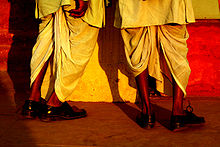Dhoti

The dhoti ( Hindi , f., धोटी, dhoṭī) is the traditional trousers of Indian men. The dhoti is the counterpart to the women's sari . It consists of a long piece of fabric, mostly thin cotton or, more recently, synthetic, which is knotted at the waist and then looped around the legs like pants. A well-known bearer of a dhoti in the West was Mahatma Gandhi .
Today, the urban middle class mainly wears the dhoti on religious occasions, usually together with the kurta , a collarless, light shirt. For men of poorer sections of the population, on the other hand, it is an everyday item of clothing (it costs only a fraction of cheap pants), and men of the older generation do not want to do without this typically Indian garment. For the requirements of the often extreme Indian climate, a dhoti is better suited than any light pants.
Today, in western circles, wearing the dhoti is often seen as a sign of backwardness. In the male business world of the middle class, one almost exclusively wears western clothing. Politicians, however, often appear in dhotis in public, usually in combination with a jacket with a stand-up collar or a sleeveless vest. Prime Minister such as B. Atal Bihari Vajpayee and also his successor Manmohan Singh can be seen very often in the media in dhoti.
The dhoti symbolizes in a certain way the Indian and also conservative element.
